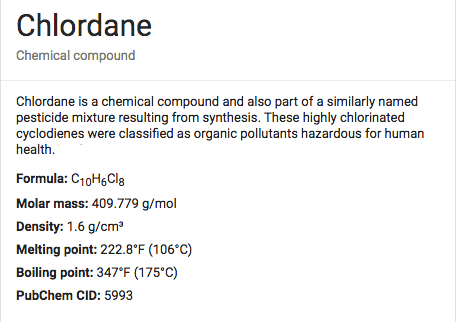About Chlordane
From The Agency of Toxic Substances and Disease Registry
Chlordane is a man-made chemical that was used as a pesticide in the United States from 1948 to 1988. It is sometimes referred to by the trade names Octachlor® and Velsicol 1068®. It is a thick liquid whose color ranges from colorless to amber, depending on its purity. It may have no smell or a mild, irritating smell. We do not know what it tastes like. Chlordane is not a single chemical, but is a mixture of many related chemicals, of which about 10 are major components. Some of the major components are trans-chlordane, cis-chlordane, beta-chlordene, heptachlor, and trans-nonachlor. Chlordane does not dissolve in water. Therefore, before it can be used as a spray, it must be placed in water with emulsifiers (soap-like substances), which results in a milky-looking mixture.
From 1983 until 1988, chlordane’s only approved use was to control termites in homes. The pesticide was applied underground around the foundation of homes. When chlordane is used in the soil around a house, it kills termites that come into contact with it.
Before 1978, chlordane was also used as a pesticide on agricultural crops, lawns, and gardens and as a fumigating agent. Because of concerns over cancer risk, evidence of human exposure and build up in body fat, persistence in the environment, and danger to wildlife, the EPA canceled the use of chlordane on food crops and phased out other above-ground uses over the next 5 years. In 1988, when the EPA canceled chlordane’s use for controlling termites, all approved use of chlordane in the United States stopped.
Need a water filter that will remove this? Checkout our whole house water filters.








